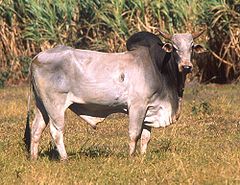
Dewlap
Encyclopedia


Longitudinal
Longitudinal may refer to:* Longitudinal engine, an internal combustion engine in which the crankshaft is oriented along the long axis of the vehicle, front to back...
flap of skin
Skin
-Dermis:The dermis is the layer of skin beneath the epidermis that consists of connective tissue and cushions the body from stress and strain. The dermis is tightly connected to the epidermis by a basement membrane. It also harbors many Mechanoreceptors that provide the sense of touch and heat...
that hangs beneath the lower jaw or neck
Neck
The neck is the part of the body, on many terrestrial or secondarily aquatic vertebrates, that distinguishes the head from the torso or trunk. The adjective signifying "of the neck" is cervical .-Boner anatomy: The cervical spine:The cervical portion of the human spine comprises seven boney...
of many vertebrate
Vertebrate
Vertebrates are animals that are members of the subphylum Vertebrata . Vertebrates are the largest group of chordates, with currently about 58,000 species described. Vertebrates include the jawless fishes, bony fishes, sharks and rays, amphibians, reptiles, mammals, and birds...
s. While the term is usually used in this specific context, it can also be used to include other structures occurring in the same body area with a similar aspect, such as those caused by a double chin
Double chin
A double chin is a subcutaneous fat around the neck that sags down and creates a wrinkle, making the owner appear to have a second chin. It is most common on people who are elderly or obese. A person of average weight can bear a double chin as well, depending on their bone structure and amount of...
or the submandibular vocal sac
Vocal sac
The vocal sac is the flexible membrane of skin possessed by most male frogs. The purpose of the vocal sac is usually as an amplification of their mating or advertisement call...
of a frog
Frog
Frogs are amphibians in the order Anura , formerly referred to as Salientia . Most frogs are characterized by a short body, webbed digits , protruding eyes and the absence of a tail...
. In a more general manner, the term refers to any pendulous mass of skin, such as a fold of loose skin on an elderly person
Human
Humans are the only living species in the Homo genus...
's neck, or the wattle
Wattle (anatomy)
A wattle is a fleshy dewlap or caruncle hanging from various parts of the head or neck in several groups of birds, goats and other animals. In some birds the caruncle is erectile tissue.The wattle is frequently an organ of sexual dimorphism...
of a bird
Bird
Birds are feathered, winged, bipedal, endothermic , egg-laying, vertebrate animals. Around 10,000 living species and 188 families makes them the most speciose class of tetrapod vertebrates. They inhabit ecosystems across the globe, from the Arctic to the Antarctic. Extant birds range in size from...
.
Many mammals such as dogs, rabbits and moose possess dewlaps. Many birds also have dewlaps, such as domestic chickens, some cracids and some guans
Guan (bird)
The guans are a number of bird genera which make up the largest group in the family Cracidae. They are found mainly in northern South America, southern Central America, and a few adjacent Caribbean islands...
. In zebu
Zebu
Zebu , sometimes known as humped cattle, indicus cattle, Cebu or Brahmin cattle are a type of domestic cattle originating in South Asia, particularly the Indian subcontinent. They are characterised by a fatty hump on their shoulders, drooping ears and a large dewlap...
cattle, the dewlap is colloquially known as the "briefcase folds".
Many reptiles have dewlaps, most notably the anole
Polychrotidae
Polychrotidae is a family of lizards commonly known as anoles . NCBI places the anole in subfamily Polychrotinae of the family Iguanidae. Four genera are common: Anolis, Norops, Phenacosaurus, and Polychrus....
species of lizard
Lizard
Lizards are a widespread group of squamate reptiles, with nearly 3800 species, ranging across all continents except Antarctica as well as most oceanic island chains...
, which have large skin dewlaps which they can extend and retract. These dewlaps are usually of a different color from the rest of their body and when enlarged they make the lizard seem much bigger than it really is, used primarily when warding off predators and for males to attract females during the mating season. Lizards which have mobile dewlaps usually accompany their dewlap movement with head bobs and other displays. Scientists are unsure about what this is meant to communicate, but it is prevalent when the lizards are courting.
See also
- Crest
- Double chinDouble chinA double chin is a subcutaneous fat around the neck that sags down and creates a wrinkle, making the owner appear to have a second chin. It is most common on people who are elderly or obese. A person of average weight can bear a double chin as well, depending on their bone structure and amount of...
- Neck frillNeck frillNeck frill is the popular term for the relatively extensive margin seen on the back of the heads of reptiles with either a bony support such as those present on the skulls of dinosaurs of the suborder Marginocephalia or a cartilaginous one as in the Frill-necked Lizard...
- WattleWattle (anatomy)A wattle is a fleshy dewlap or caruncle hanging from various parts of the head or neck in several groups of birds, goats and other animals. In some birds the caruncle is erectile tissue.The wattle is frequently an organ of sexual dimorphism...

